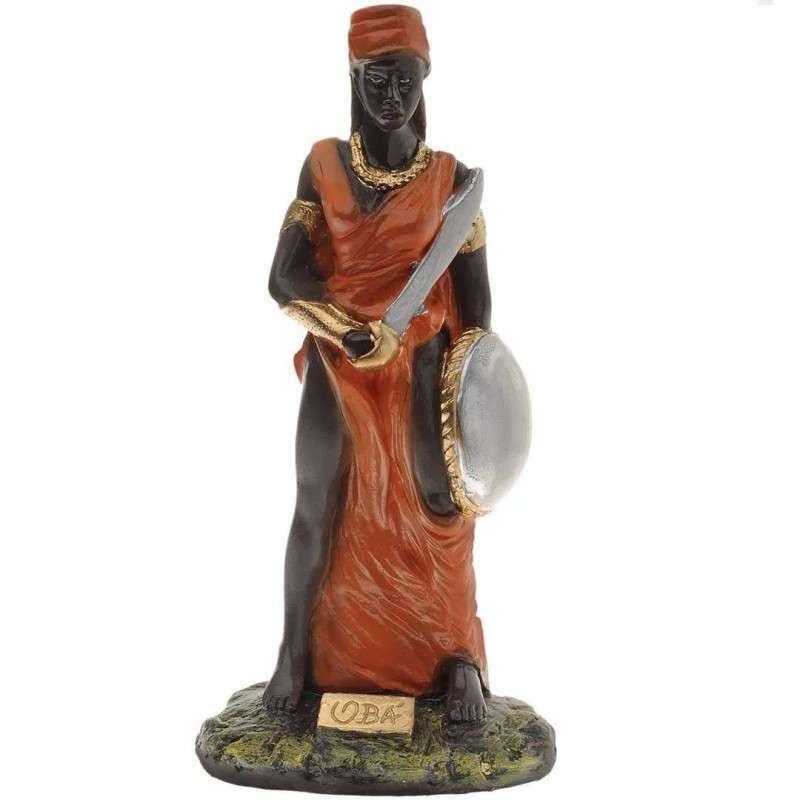



Image of Oba
Material: Hand-painted plaster.
Size: Approximately 10 cm tall.

Security policy

Delivery policy
Obá is a deity originating from the people who inhabited the sub-Saharan territory, corresponding to the region of Nigeria, Togo and Sierra Leone. She is part of the Yoruba pantheon, a rich religious tradition that encompasses several deities associated with different aspects of nature and human life.
Its name derives from a river in Nigeria. According to mythology, she is the daughter of Iemanjá, the queen of the sea, and Oxalá, the creator. She was the first wife of Xangô, the lord of thunder.
The courageous warrior of the Yoruba pantheon is widely recognized for her strength and dexterity in combat, represented always carrying a shield and a bronze sword. She was feared by many male Orixás, accumulating notable victories in her battles against other gods. She defeated Exu, Oiá, Oxalá, Orumilá and Oxumarê, demonstrating her supremacy and divine power.
The cult of the goddess, of sub-Saharan origin, arrived in Brazil with the African diaspora. Throughout our history, Afro-Brazilian religions have faced persecution and marginalization due to prejudice and religious intolerance.
However, the resistance of these religions and their adherents allowed their traditions to stay alive and expand. In this sense, in Brazil, Obá is syncretized with Joan of Arc, a Catholic saint with an equally warrior character and masculine traits. In some traditions, she is also syncretized with Saint Catherine of Siena.
oba and oxum
The myth involving Oba and Oxum is one of the best known stories in the Yoruba pantheon, which explores the feelings of love, jealousy and betrayal between these two goddesses.
The two Yabás shared a love for the same Orixá, Xangô, the lord of lightning and thunder.
Obá always tried to copy the recipes that Oxum prepared for the god. Furious with this intrusion, the goddess of beauty decided to set a trap for her rival.
Oxum called the warrior goddess to accompany the preparation of a dish that, according to her, was the favorite of the lord of lightning. Upon arriving in the kitchen, the goddess of turbulent waters found that the rival was wearing a scarf tied to her head, hiding her ears. While preparing soup for the beloved, Oxum said that the mushrooms in the broth were her ears.
The lord of thunder took the soup with gusto. The warrior goddess then decided to repeat the recipe, cutting off her ears, which caused the god to be repulsed. Oxum then removed the scarf, revealing his intact ears.
Furious with the trap, Obá fought with Oxum. The god, enraged, invoked his thunderbolts. Afraid, the two Yabás fled and turned into rivers. The meeting of these rivers, known for the agitated waters, symbolizes the fight between the goddesses for the love of Xangô.
This is why the goddess is often depicted wearing a turban or with her hands covering her ears.
Features of Oba
The Orisha Obá is associated with Wednesday. Its representative colors are brown, red and yellow.
Its sacred symbols include the Ofange (sword) and the Copper Shield, in addition to the Ofá (bow and arrow). The goddess is connected to turbulent waters, including the powerful pororocas (a natural phenomenon produced by the meeting of river and ocean currents).
Her spiritual domains encompass love and professional success. She is revered with the greeting "Obà Xiré!" .
The offerings and dishes (ebós) dedicated to this Orisha include the uniquely shaped acarajé, aberém, black-eyed peas and amalah (okra caruru).
According to tradition, the children of Obá are obstinate and sincere people, being able to hurt others with their frankness. However, they are faithful to those they love, a trait inherited from their mother Obá. They are jealous and invest heavily in their professional careers.